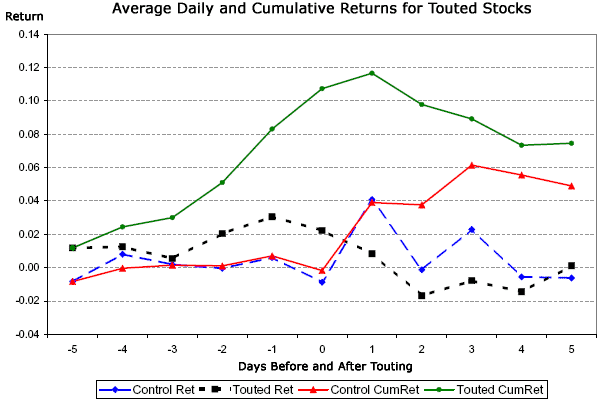Does touting of penny stocks via email spam work? If so, for whom? In their July 2006 paper entitled “Spam Works: Evidence from Stock Touts and Corresponding Market Activity”, Laura Frieder and Jonathan Zittrain assess the impact of unsolicited email touting on Pink Sheet stock prices. They also investigate who wins and who loses from such attempted manipulation. They construct their test sample from 75,415 unsolicited email messages touting a total of 307 mostly Pink Sheet stocks between January 2004 and July 2005, along with associated price and volume data for these stocks. They then create a control sample of randomly selected comparable Pink Sheet stocks. By comparing the test and control samples, they conclude that:
- There are over 100,000,000 email spam stock touts per week.
- On average, stocks heavily touted via spam show a significantly positive return on the day of and the day before touting.
- Spam touting also produces a significant increase in trading volume. On days when there is touting (no touting), a touted stock is the most actively traded stock 81% (6%) of the time.
- Investors who respond positively to touting lose, on average, 5.25% in the two day period following touting (not including trading costs).
- The more spam there is touting a stock, the greater the effect on price and volume. For the most heavily spammed quintile of stocks, the 2-day loss for buyers approaches 8% (not including trading costs).
- The average spam touting effect grows in magnitude from 2004 to 2005, suggesting that spammers are improving their reach and/or focus.
The following chart, taken from the paper, depicts the average effect of touting on the prices of targeted stocks from five days before spamming to five days after spamming. Day 0 is spam day. The dashed black line shows the average daily returns for touted stocks, while the solid green line shows the average cumulative return. The dashed blue and solid red lines show comparable data for a randomly selected control group of similar stocks. Results suggest that touters buy ahead of spamming and/or select stocks already trending upward, and then sell at higher prices into the bullish liquidity provided by those responding to the spam.

The authors note that the standard deviations of their price data are large. While the potential returns are substantial, trying to trade with the spammers is risky.
The authors make available the raw data for this study.
In summary, investors/traders who take the advice of spam stock touts are likely to lose big and fast.